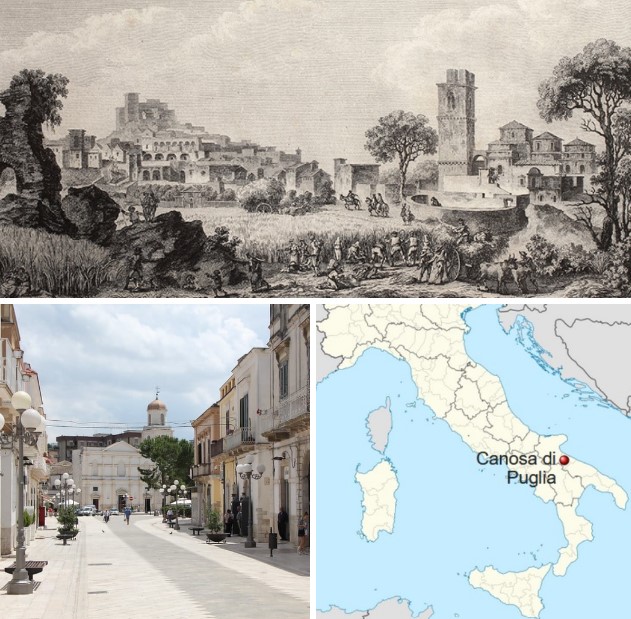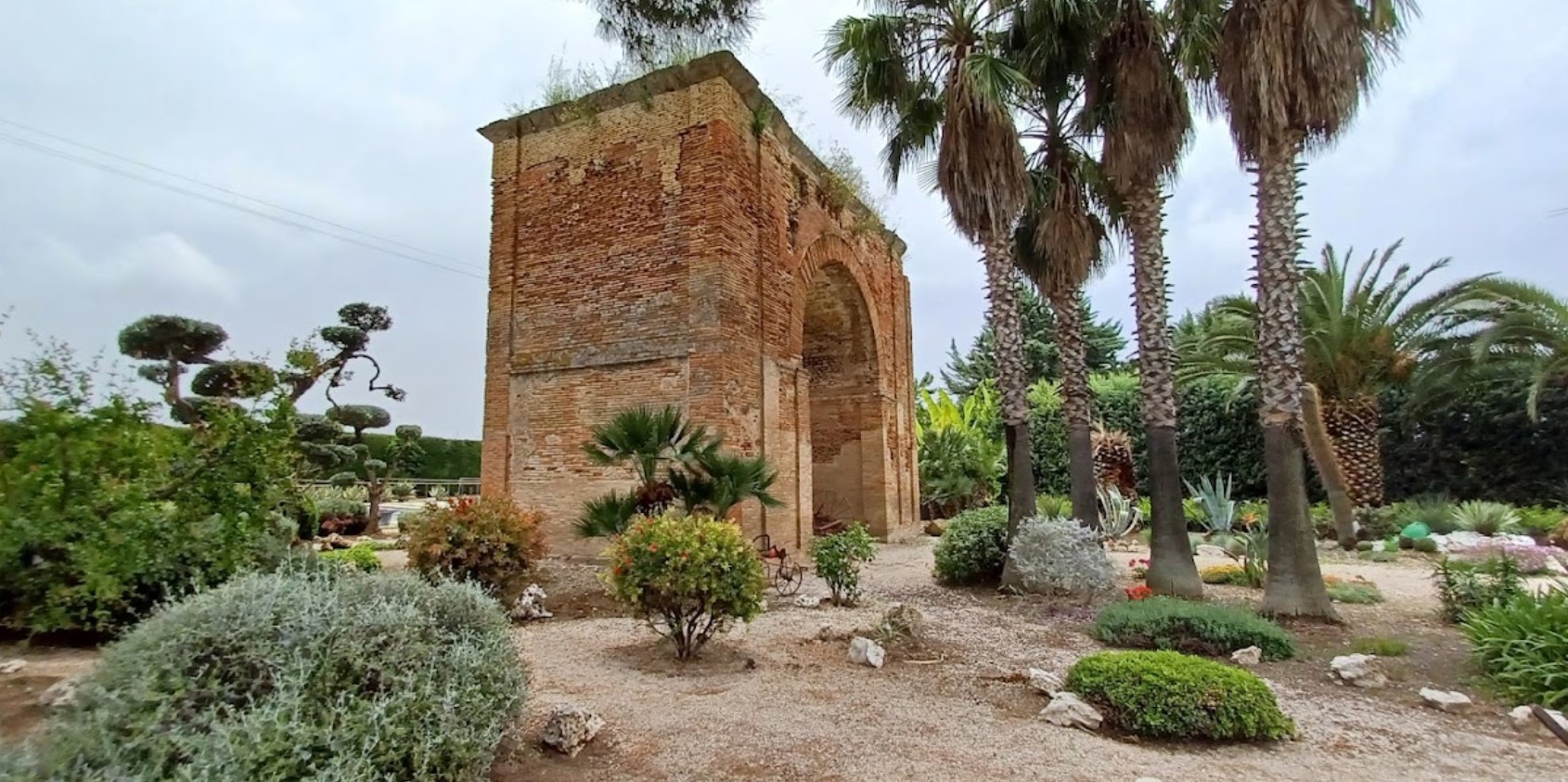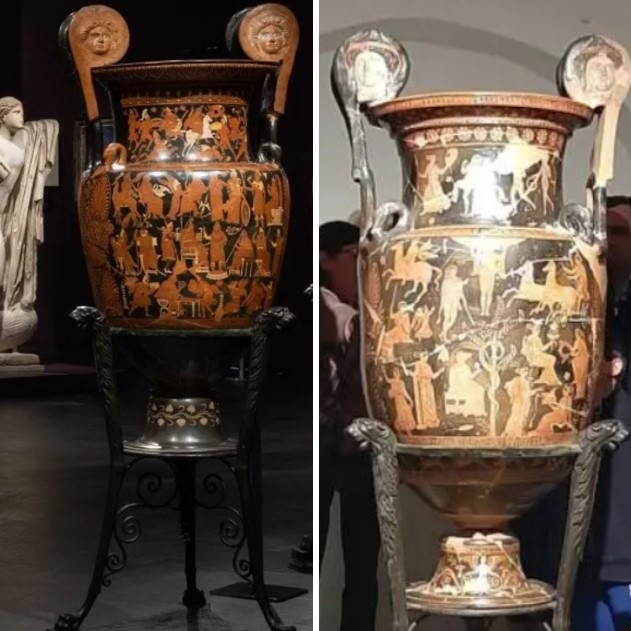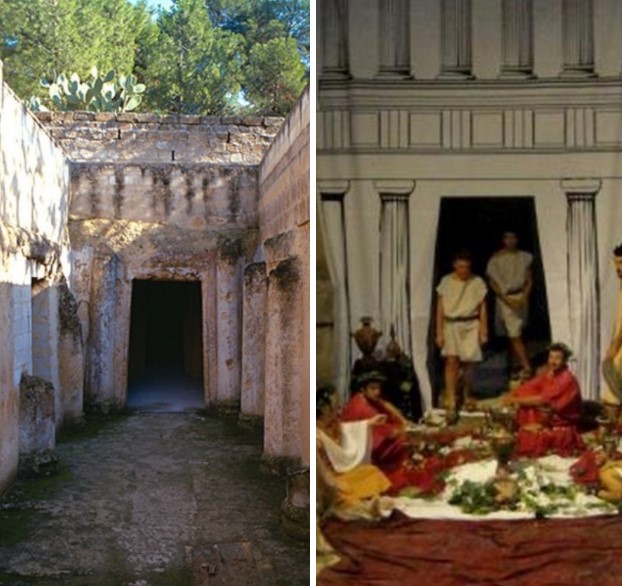Darius Vase at Canusium
Barletta-Andria-Trani, Italy
Ancient Canosa or Canosium is situated on the northwestern edge of the Murge plateau, overlooking the Ofanto Valley and the Tavoliere delle Puglie plain. This captivating town boasts a history spanning thousands of years. Within its bounds lie ancient traces from prehistoric times, the subterranean treasures of Daunian hypogea, fragments from the Magna Graecia world, and testaments to the might of Rome. Beyond antiquity, the town offers evocative glimpses into the Middle Ages and is rich with palaces and monuments from subsequent eras. Due to its wealth of historical and artistic evidence, it stands as one of the most precious centers in all of Southern Italy. These treasures are not concentrated in a single archaeological park but are scattered across multiple locations throughout the town.

View of Canosa di Puglia (print) by Desprez Louis Jean, Dambrun Jean (sec. XVIII/XIX) and today
Canosa di Puglia today is known as the 'city of the hypogea', but in antiquity it was Canusium ( Κανύσιον), a thriving city of commerce and industries, especially of wool and pottery (from the 4th century BCE).
According to a legend, it was founded by the Homeric hero Diomedes and derives its name from canis (dog), the animal that accompanied the hero while hunting, or from the animal associated with the Greek-Eastern deity Aphrodite, according to the Latin commentator Servius.
We certainly know that the city has Neolithic origins (6000-3000 BCE) and that its earliest nucleus is attributed to the Greeks, as the inhabitants were bilingual during the empire of Augustus. Canosa reached its peak in the IIIrd century BCE, when it welcomed the Romans who had escaped the battle of Cannae, one of the greatest tactical feats in military history and one of the worst defeats in Roman history. To confirm the wealth of the city, numerous funeral hypogea have been discovered, many containing furnishings such as the famous polychrome vases now preserved in the museums of Naples, Bari, and Taranto, as well as in numerous private collections. Among these hypogea, one in particular is situated near the Via Trajana and the Honorary Arch, it is no longer open to the public today. This is the hypogeum of the Darius Vase.

The Onorary Arch can be visited and is located inside a garden centre, Canosa di Puglia See what it looks like today
The hypogeum of the Darius Vase was discovered in 1851. Inside its semi-chamber tomb, there is a large volute krater among the various finds: it is 1.3 meters in height and 1.93 meters in circumference. Today, it is kept in the storage of the National Archaeological Museum of Naples and is a work not normally on display. The hypogeum takes its name from the exceptional collection of Apulian ceramics with red figures found inside and attributed to the so-called Painter of Darius. On one of these vases, in the middle of a lively scene with sixty figures, stands Darius, king of the Persians, enthroned. His name, Dareios, is written on the black background to the right of his head.
Unfortunately, of the hypogeum, probably consisting of a dròmos and two small rooms, reinterred after the removal of the finds, we know only an approximate location.
The hypogeum (or chamber tomb) is a refined, rich, and monumental type of tomb of clear Hellenic origin. Normally, it is entirely built in blocks, or dug in the lower part and constructed in the upper part. However, in Canusium, it is entirely excavated from the rock, specifically from powerful tuff layers.
The plan of the chamber tomb is typically regular and square, consisting of either a single room or several rooms arranged symmetrically around an axis formed by the dròmos(an entrance passage). These rooms, through repeated additions, can form complex cruciform layouts. The dròmos serves as the access to the tomb, typically taking the form of a long, wide inclined plane or a large staircase that ends in an external vestibule. From this vestibule, the entrance (or entrances) to the tomb opens, closed off by massive monolithic slabs.
This type of burial spread to Canosa and Daunia in the Hellenistic age (4th-3rd centuries BCE) and was the prerogative of aristocratic families. During this time, Canosa was an important cultural center, known for producing prestigious ceramics that were traded with the colonies of Magna Graecia and throughout the Eastern Mediterranean.

The Darius vase in the Archaeological Museum of Naples (340-320 BCE) today.
Volute crater with masks in apula ceramic with red figures. Black paint with special overpainted.
The "Darius Vase" is an important work of Apulian vase painting. It is a famous vase painted by an anonymous ceramist from Apulia in Magna Graecia (c.350-300 BCE), commonly called the Darius Painter, who is considered the most eminent representative of the 'Ornate Style' in South Italian red-figure vase painting.
He is regarded as the first painter to fully exploit the possibilities of large-format vase painting. His drawing style is highly esteemed, particularly for his depiction of faces in a three-quarter profile.
The vase was produced between 340 and 320 BCE, probably in a large factory-like workshop in the Greek city of Taras (now Taranto) in Magna Graecia, well before its fall to the Romans in 272 BCE.
At the beginning, it was thought that the vase was inspired by a scene from the tragic poet Phrynichus (Athens, c. 535 BCE - Sicily, c. 476 BCE). He was one of the earliest Greek tragedians. Some ancients regarded him as the real founder of tragedy based on historical arguments. He was also the first to introduce female characters on stage, represented by male actors with masks.
Because Phrynichus' genre had matured from the patriotic pride arising from the conflict between the Greeks and Persians, it was thought that the scene immortalized the moment when Persia was about to declare war on Hellas. However, recent studies have concluded that the scene references the revolt of the Greek cities of Asia and echoes the troubled period of the wars against the Lucani and Messapi in Magna Graecia, during the period of activity of the painter of Darius.
Magna Graecia is a complex historical and cultural phenomenon that originated from the coexistence of the Greeks with the indigenous peoples of southern Italy at the end of the seventh century BCE. Greek colonization in southern Italy continued from the end of the 8th century BCE until the Roman conquest during the 3rd century BCE.
Thus, the painter used space symbolically to allude to the theatrical space: the choir in the lower register, the proscenium in the center, and the tribune of the gods at the top.
It contains several inscriptions, some naming individual figures, but there are also collective names (such as Persai, Persians). These inscriptions can be seen as tituli. All available space on the vase is used for figural depictions, arranged in two or three registers. Some individual zones are structured by opulent ornamental friezes.

Ipogei Lagrasta is the most important funerary complex of Canusium (late IV and I century BCE) - A funeral ceremony in front of a hypogeum
The neck of the vase shows Bellerophon riding Pegasus; to the left a young man clutches a laurel branch and in front of him stands Poseidon; to the right, Pan is in front of Athena.
The middle frieze has the Chimera between amazons in the center; below, there are two fallen amazons and a marsh bird.
Above Darius stands a line of Greek gods: Zeus (holding a winged thunderbolt) with Aphrodite and Artemis (riding a stag) on the left, and Athena (holding a shield), Hellas (standing), Hecate (holding two torches), and Asia (seated on an altar next to a pillar holding a head, possibly of a xoanon) on the right.
Darius III is shown seated, wearing a long, ornate, sleeved robe and a high Persian hat. A bodyguard stands behind him. Darius is listening to a messenger in front of him on a circular podium , to the presence of dignitaries and an elderly (maybe he is a pedagogue).
The last frieze shows around the tax collector, the Royal Treasurer, five oriental, three of them in gesture of supplication. The treasurer is seen receiving payments by various conquered nations, whose representatives crouch before him. On a table lays a calculating table (a reckoning board or abax, used for complicated calculations), with a number of small pebbles or counters in front of the Greek numerals for calculating large numbers. The symbol "O" appears in the calculation table, a Boeotian symbol for the obol, or small unit. The use of pebbles on a board to make calculations is illustrated down to modern times by the fact that calx is "pebble" in Latin, which is the etymological root for the word "calculation".
The board contains the letters M (= 10.000), Ψ (Boeotian for 1.000), H (= 100), Δ (= 10) and (=5, or possibly the unit symbol for the Drachma). White pebbles are added next to each letter in order to give the number of each quantity unit. Next to them appear the former symbols used to represent the Greek coins: Obol (Boeotian symbol O, 1/6 of a Drachma), half an Obol (С) and a quarter of an Obol (T). These symbols resemble those found in the Salamis abacus. The number here shown is probably 1741 and 4/6 Drachms. The tax collector also holds an open diptych (two-leaved wax tablet) in which can be read the letters TAΛNTA:H, presumably meaning tal'anta hekaton' ("one hundred talents").
It is possible to admire other masterpieces by the painter of Darius at the National Archaeological Museum of Palazzo Sinesi in Canosa di Puglia.
Via John Fitzgerald Kennedy, 18, 76012 Canosa di Puglia (Barletta-Andria-Trani)
